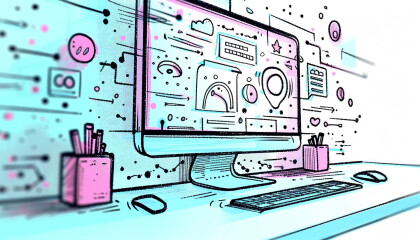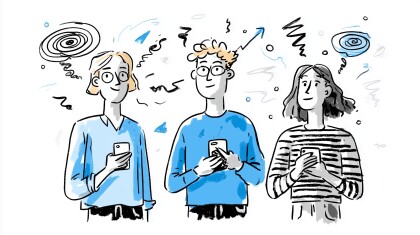I tend to get one of two responses from people who ask me what I do for a living.
When I tell them I’m the Resident Anthropologist for a software development company, they tend to either look blankly at me until I qualify my statement, or they look blankly at me while pretending to understand what I said.
So, I thought it would be fitting to provide a brief overview of how anthropology can be a powerful tool in the workplace.
At a basic level, applied anthropology at Media Suite is about working with people. It’s thinking about the impact people have on business, and the impact business has on people. As a qualified anthropologist I switch between numerous functional roles that may seem disjointed from an outsider’s perspective, but fit into a seamless picture when viewing a workplace in a cultural context. This includes meeting facilitation, communication, relationship management, project leadership, research, and business storytelling – among other things. Each of these roles work toward the same goal – I pay attention to Media Suite’s culture to help aid its growth.
Of course, this begs the question – why does Media Suite place such emphasis on culture?
Media Suite wants people to enjoy their work. Happy people are more productive and more likely to bring their A-game. So Media Suite does everything it can to build a healthy, happy company culture. Although culture can’t be manufactured, we think it can be fostered.
So, how does this work at a practical level?
There are two elements:
- Cultural overview
- Doing stuff
Cultural Overview
While there is no universally agreed definition of culture, the following version has all the best bits of most definitions:
shared beliefs, values, customs, behaviours, knowledge and technologythat the members of a society use to cope with their world and with one another – that are transmitted from generation to generation through learning. - Schein, 1984
To understand this at a practical, real-world level, I’ve applied some Media Suite examples to to create a cultural inventory. I find the inventory to be a useful way of looking at Media Suite from an outside perspective. As an outsider we can see the organisation as a complex interconnected human system that can be tweaked to create different outcomes.

Doing Stuff
Once I have a general overview of the company’s culture, I can help shape its evolution. Here are three ways I support Media Suite’s growth:
- Advice: I advise decision makers on people and culture-related topics.
- Translation: I translate business concepts into visuals, strategies and plans.
- Representation: I represent company interests and manage relationships.
I’ll spare you the details of my to-do list, but here’s the basics on how cultural understanding enables advice, translation and representation of the company’s interests.
By conducting a cultural inventory, I can build a deep familiarity with the high-level view of an organisation. Learning about the history, people, processes, tools, ideologies and desired future allows me to frame the organisation as a unit with goals to be achieved. Those goals may require different outcomes from different components (people, roles, responsibilities, tools, etc.) which can then be identified, considered and addressed.
For Example:
- Advice: When I first came to Media Suite I was asked to help conduct the Peer Review process, and offer suggestions for how we might adjust it. I started by reading through every bit of notation from previous sessions and identified common themes. I noticed that there were some consistent patterns that included a lack of consistency between personal goals which made them difficult to record, measure and possibly remember. It also seemed like there was a lot of recent growth which required some reiteration of the company’s story and plans for the future. I then interviewed team-members who had gone through each peer review session to determine what pros and cons they had experienced.
After getting feedback from the interviews I compared them with my personal observations. At this point I was prepared to offer advice for how we might adjust the peer review process to align with the company’s goals and respond to people’s feedback. Some of the changes included reiterating the company’s vision and goals prior to each session and encouraging team-members to produce consistent, achievable goals that align with the company vision.
- Translation: As a part of my work with the peer review process we decided that the company’s growth calls for some adjustments to the company’s messaging. So I set a recurring meeting with the Managing Director to start working through his thoughts on Media Suite’s intended future. We started by discussing how communication currently worked in the organisation, and whether or not we thought the key messages were succinct and well understood. This helped us realise that numerous individual discussions had occurred, but a more formal presentation of the company’s goals could be helpful. In response we poured ideas onto a whiteboard and mapped the relationships.
This was the first step in documenting a picture of our current position and plans for the future which could then be presented in a Learning Lunch prior to peer review sessions. This will also serve as the basis for recurring presentations. Finally, it contributed to the framework for our messaging architecture and further discussions about the way we tell our story.
- Representation: Finally, because of my work with the company’s culture, goals and vision for growth, I’m in a position to help tell our story to new people. Some of the ways I’ve done this so far include holding conversations with the University of Canterbury regarding an internship programme. I’ve helped my colleague Kerry promote Media Suite within the Christchurch City Council at their first Smart Cities Expo. I recently manned the booth at Tech Summit with a pack of orange-shirted colleagues, and will represent Media Suite as a sponsor at GovHack’s award ceremony in Wellington.
When I meet new people they’re always interested to know what Media Suite does, and what kind of problems we solve. If I didn’t have an idea of the company as a whole unit with its history, current state and future plans I think I would struggle to answer a lot of the questions I receive. In this way I find a holistic anthropological view of the organisation quite useful.
So when I’m asked what I do for a living, and proceed to qualify what Media Suite’s Resident Anthropologist does, it sounds something like this.
“Basically, when someone’s afforded the time, tools and relationships necessary to study a company’s culture, they’ll develop a unique insight that can be mirrored to decision makers in order to validate their assumptions, spark conversation, plan for the future and encourage positive outcomes. “
So, that’s what I do.
Banner image: Photo by Klub Boks














